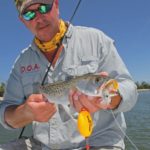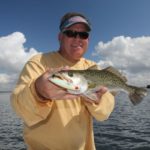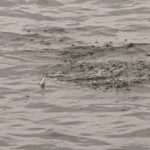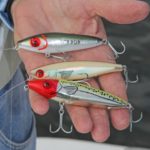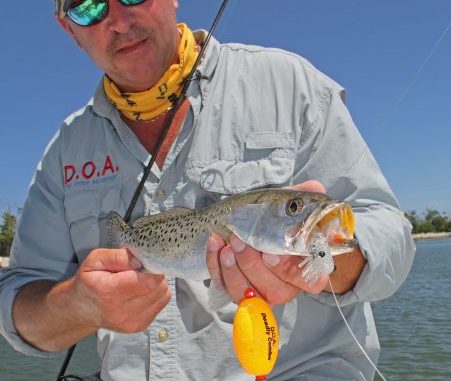
Anyone can catch a trout by chunking live bait, but these guides think the best bet for consistently putting fish in the boat is to go artificial.
“Oh what a tangled web we weave when first we practice to deceive.” Yeah, Sir Walter Scott’s insight rings true for interpersonal relationships, but when it comes to speckled trout fishing, the Scottish writer can stick that nonsense in his bait bucket.
Tricking trout is the name of the game.
No doubt, live shrimp and minnows catch plenty of specks, but artificial baits properly applied can yield tremendous results. Just ask Capt. Anthony Randazzo, who visits with the Mississippi Delta’s trout on a regular basis and does his best to fool the freckled fish — and their silver cousins — with man-made offerings 99 percent of the time.
“Fortunately, we have a very healthy speckled trout resource in and around the Mississippi River Delta,” Randazzo said. “There are plenty enough opportunities to catch more than an average number of trout from March through December without resorting to live bait.
“We may have to think a little harder, fish a little harder and fish a little longer than the live bait anglers. “
But it’s all worth the effort because of the inherent benefits of artificials over natural baits, Capt. Jeff Poe of Big Lake Guide Service said.
“The biggest benefit is just the amount of water you can cover,” Poe said. “If you’re using (natural) bait, you’re pretty much pulling up to a spot, tossing it out and waiting. If the fish are there, they bite and if they’re not, they won’t.
“With artificials, you’re constantly moving and constantly covering water. If you move 5 feet, it can be the difference between catching a fish on every cast and not catching them at all.”
Popular imposters
For most of his trout trips, Poe favors soft plastics, particularly MirrOlure Lil’ Johns, Norton Sand Eels, H&H salty grubs and cocahoe minnows, and split tail beetles on ¼- to ½-ounce leadheads.
Temperature and water current are the main determinants for jig size — heavier for swift water and summer’s deeper fishing, lighter for cold, still water.
“All these baits will work year round, but there are certain times that are better than others,” Poe said. “The grubs are pretty much a year-round bait. I like the beetle in the summertime when we have a lot of shrimp in the water. The Lil’ Johns and the Sand Eels — the peak time is spring and early summer, and then we get back on them in the fall.”
For hard baits, Poe throws a lot of MirrOlure She Dogs, Rapala Skitterwalks and Heddon Zara Spooks. He keeps a variety of sizes handy to match the conditions at hand, but as a general rule he finds the bigger topwaters most productive while big trout are more abundant in the cooler temperatures of fall-winter, and smaller baits tend to be more productive for the hot summer months.
Below the surface, suspending and slow-sinking baits like MirrOlure’s Catch 2000 and the classic 52M, along with Paul Brown soft-bodied baits, will tempt trout that don’t want to commit to a surface attack.
As a general rule, Poe said he does better with soft plastics in off-color water, while greater visibility increases the hard-bait potential.
Randazzo fishes a similar mix of baits, adding in DOA shrimp fished under rattling corks and ½- to 1-ounce jigging spoons.
Cork rigs offer fish-calling sound and disturbance that’s effective just about any time of the year, while the spoon excels in the last quarter of the year when the water’s cold and the fish are deep.
Target zones
Noting that seasons and salinity levels principally position the fish, Poe chases trout from the Gulf’s nearshore rigs all the way up to Lake Charles. Trout need higher salinities during spawning season, but they’ll tolerate a much lower parts-per-thousand reading during winter for the warmth and stability of upstream waters.
Randazzo said anglers visiting his lower Delta region have a huge variety of structures to target throughout the trout season.
“I love to fish over shallow oyster beds in March and April, as the trout begin the first spawns of the year,” he said. “Any reefs in less than 4 feet of water with good tide movement and baitfish present will be golden. Inside bays from Port Sulphur to Buras on both side of the Mississippi River will be productive.”
Targets change as summer settles in.
“From May through August, we are targeting specks around oil and gas platforms with good bottom structure in addition to the platform foundation,” Randazzo said. “These platforms may be one to 15 miles off the coastline. Deeper platforms farther out offer cooler and more oxygenated water during the hot summer months.
“During this time frame, I will also look for specks to concentrate near barrier islands along and near the coastline where hard sand bottoms and access to deeper channels exist. Shallow water always presents an advantage for feeding gamefish, but they like the availability of deeper water close at hand when water temps rise in the midday hours.”
When specks begin migrating back toward the bays in September, Randazzo looks for them to gather in big numbers around granite boulder structures like jetties. He also investigates the various smaller granite boulders used to fortify oil/gas pipeline crossings.
In fact, any of these rock formations near the coastal areas, Randazzo said, will hold trout as they begin to move inland.
Randazzo pointed out that the fourth quarter of the year finds the highest salinities of the season within the Mississippi River Delta. At this time, he’s targeting a variety of bottom contours, preferably with accompanied bottom structure.
He said specks will slowly begin migrating up the passes into the main channel of the Mississippi River. Depending on rainfall in the Midwest, Randazzo will look for specks as far north as Empire (20 miles north of Venice) by Thanksgiving.
“I simply suggest treating the river as a reservoir,” Randazzo said. “It’s a lot like bass fishing. I look for eddies in the tranquil currents (usually 8 to 20 feet deep) and any wood or rock structure near the shores that looks fishy.”
Presentation tactics
High-current situations, Poe said, offer a shining example of how artificials offer not only water-coverage benefits but also presentation control.
“Most of the time, I try to work my artificial sideways to the current,” he said. “If the current’s moving east and west, I’m casting north and south because I want that bait to sweep: It looks more natural and you’re covering that water. It’s working in an arc, more than just straight out there and straight back.
“Sometimes they want it that way. I’ve seen it where if you weren’t working your bait dead against the tide, you weren’t catching them.
Poe said that, the majority of times, working the current dynamic and strategically placing his artificials for various sweeping presentations is essential to reaching trout that patrol the current edges to pick off passing meals. Certainly, natural baits will get bit too, but they tend to end up where they end up.
“Speed is the most important thing,” he said. “When I see people in my boat who are not catching, they’re either going too fast or too slow. It doesn’t matter what you’re using; it can be topwaters or a jig.”
For example, Poe said just about the only time he catches trout hugging the bottom is in a high-current situation. Here, he said, it’s a low and tight deal, where dragging the bait with only 3- to 6-inch twitches gets the bites while excessive hopping gets ignored.
“In another area of the lake, I’ll move away from the strong current where the trout aren’t trying to get down and get out of the current,” Poe said. “Then, you work a jig and you almost can’t go too fast. You work it with a lot of hopping, maybe making it jump 3 to 4 feet and sweeping your rod in big strokes.
“You just have to let the fish tell you what they want.”
When trout are thick, what they want is simply a target to gobble. Pickiness goes out the window, and doubling your chances is a wise adjustment. For example, Howard Hartley of Berwick likes a cocahoe minnow on a ¼-ounce jighead — LSU colors for his lower Atchafalaya Basin homewaters, black-and-chartreuse when he heads west toward Grand Isle.
But in both areas, he’ll often double up for double the fun.
“When they’re really biting, sometimes we’ll rig the cocahoe minnows tandem style and catch trout two at a time,” Hartley said. “If I’m looking for them, I’ll fish two different colors, but once I find what they like, I’ll use two of the same color.
“Sometimes, it will barely hit the bottom and you’ll come tight.”
Calling trout consistency an ongoing experiment, Randazzo offered this advice for keeping the action rolling.
“You will learn the best methods for working each type of lure; however, the methods all need tweaking when they don’t produce,” he said. “Don’t simply give up and switch to another lure if you feel you have made the best choice for the conditions/location.
“Burn that jig back to the boat if you have been getting the most success by bumping it along the bottom. Walk the dog quickly with your topwater plug if you’ve been having the best success with a stop-and-go retrieve. It’s all really a puzzle that the fish will help you put together if you just make mental notes and have patience.”
Visit Capt. Jeff Poe at www.biglakeguideservice.com or Capt. Anthony Randazzo at www.paradise-plus.com.
